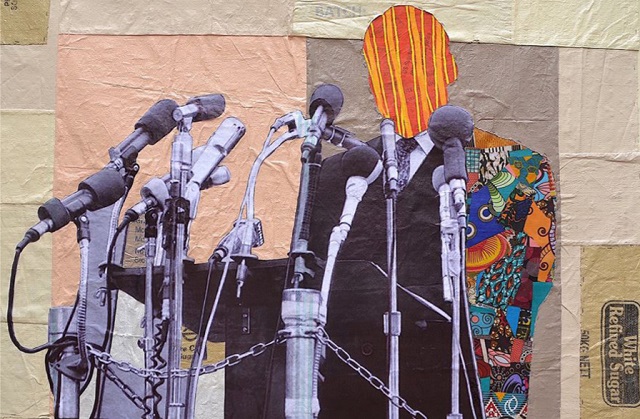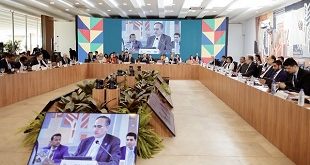
Since his groundbreaking public art performance in 2012 dubbed Secolliville, in Bukoto a Kampala city suburb and later during the Laba!
Kampala, Uganda | DOMINIC MUWANGUZI | Street Art Festival 2013, artist Collin Sekajugo’s art has set unprecedented waves of interest and curiosity on the Kampala Contemporary art scene. This exceptional approach to art is still visible in his recent body of work titled: This is Uganda- C’est O’ganda; motivated by ever-conflicting and complex identity of Uganda. According, to the artist with a social consciousness, there’re widespread divergent views on the country with a section of the public describing it as Gifted by Nature, while others defining it as chaotic or a habitually politicking space. In the context of this prevalent conflicting identity, the multidisciplinary artist takes a deep insight into the social, economic and cultural landscape of Uganda, from a perspective of a global citizen, he’s intensely inspiring for.
In this attempt to interrogate such complex identity, the artist identifies themes that are familiar to Uganda’s social and economic terrain like migration, poverty and starvation, education, environment protection and healthcare. These topics provide fertile ground for critical dialogue in Uganda since they conspire to the shaping of the identity of many Ugandans; regardless of their gender and social strata. A central medium in both the art performances and paintings are the quilted empty food sacks that denote the seemingly endless need for humanitarian aid in a poverty stricken country like Uganda. Poverty seems to be the genesis of Uganda’s problems. It is partly because of poverty and starvation that influences thousands of migrants to Uganda. It is also the reason why education and healthcare in Uganda has been reduced to the survival syndrome because of an insatiable yearning for quick fixes by both those in service sector and the populace. By evoking the subject of poverty, Sekajugo is as relevant as authentic in his art and this obviously lures the attention of the local audience into his work.
This ability to connect with his audiences his traceable is in his previous body of work: What is Beautiful. In the assemblages he constructed from denin material and Kitengi fabric, he was able to lure the attention of the public to his work because both materials are familiar to the Uganda audience. Denin, a sturdy material is a common fabric among many young people in Kampala because it is the fabric from which jeans- a fashionable garment- are produced. It was also originally used to make workmen clothes in heavy factories. For Kitengi, a colourful fabric often identified to the East African region, the textile is used to make elegant clothes for both young and old across the county by local tailors. The idea of appropriation of both materials into the artist’s work was symbolic to his awareness and successful attempt in creating a local visual language for his work. It was also a showcase of his studio adeptness within the context of pushing the boundaries of traditional art making.
In recent artworks, the delicate stitching together of the quilted bags- often in different shades- to create a synthetic surface on which he digitally prints on the imagery, echoes the theme of environment sustainability that runs through his past and present art. The food sacks though useful l in the storage of food, they are often dumped after use within the community and consequently create a problem of environment conservation. Additionally these collages invite conversation on durability and sustainability of the art to counter the common narrative within global art circles that Africa does not produce art. As a global citizen- an identity he’s intensely inspiring for- Sekajugo is accurate with his theme of environment sustainability because it remains a critical concern for many countries globally. Conversely, Uganda still grapples with the problem of environment pollution from discarded synthetic material like polythene bags that chock the earth, leading to low yields and finally hunger among the communities across the country. Yet a more startling feature in this art is the delicate interplay of the artist’s personal identity as a multi- ethnic individual –#sekaidentism- and the complex identity of Uganda. In a way, the two personas seem to be identical with similar conflicting individuality within the context of the fast engulfing globalization. By such similarity, the artist aptly submits himself as a metaphor to this inconsistent identity and therefore reiterates the discourse on the meaning of the words: ethnic or local identity; in these contemporary times where everyone wants to be part of a larger identity. The notion of ‘intensely inspiring for a global citizen identity’ conveniently applies here.
This is Uganda, the body of work, is an insightful perception on the complex and conflicting identity of Uganda in these contemporary times. In order to electrify his message, the artist appropriates familiar tools like quilted bags in his artworks to make it palpable to larger audiences. At the same time he induces the idea of recycling that is still a nascent venture in Uganda. More so, his faceless image that sometimes makes appearances in the artworks evokes the idea of conflicting identity that is not only familiar to him as an artist of multi-ethnic origin, but as someone who’s ‘intensely inspiring a global citizen identity’ . The same faceless technique is used to imply the complex identity of Uganda: Is it gifted by nature or chaotic?
****
 The Independent Uganda: You get the Truth we Pay the Price
The Independent Uganda: You get the Truth we Pay the Price



